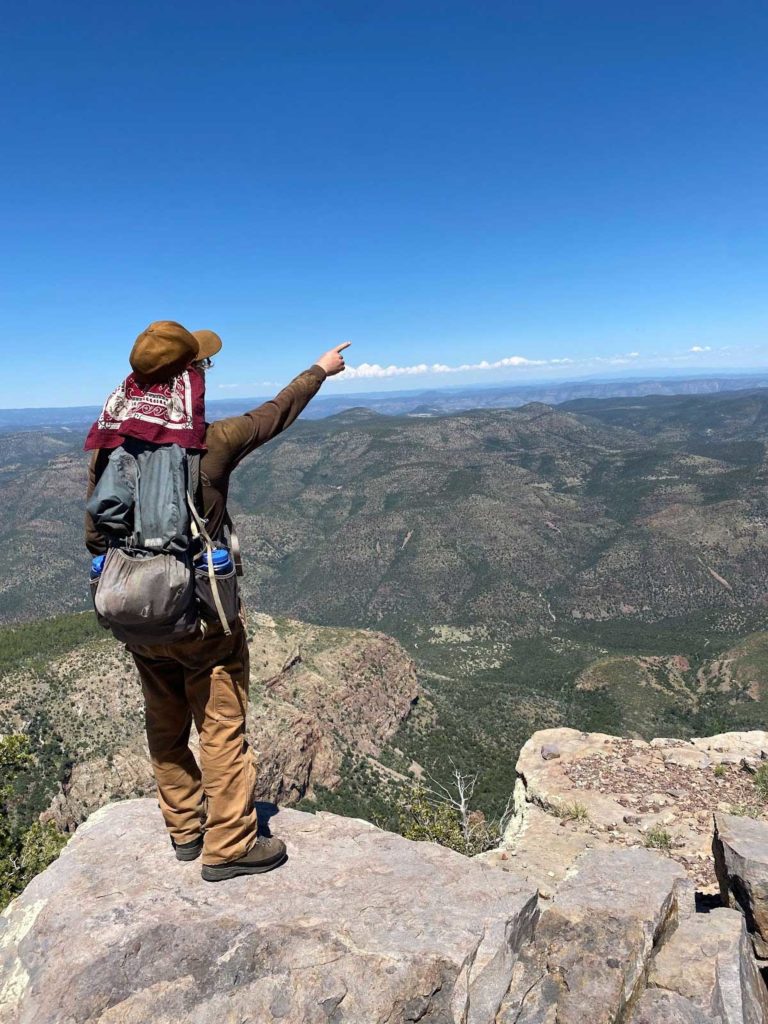
Written by Dexter Kopas, Wild Stew Field Crew Leader
We’re back! Back to the Strayhorse Trail #20 on the Apache-Sitgreaves National Forest for a sequel to the work we did last hitch. We got the trail restored through the major burn area for a total of 4.6 miles so far. Along the way, we cut another 95 logs off the trail, retreaded and removed grass from numerous sections of trail, and built 36 more cairns to show the path of the trail where it goes through more faint or damaged areas.

Late May is usually one of the hottest and driest times of the year in Arizona, and this hitch did not surprise us. Though we were happy to be at a comfortable elevation of 6,000-7,000 ft, temperatures still reached into the lower 80s. This may seem tame to anyone working outside in the Sonoran Desert right about now, but the sun still got to us, helped by low humidities. The benefit of the low humidity was that evaporative cooling was highly effective, either from sweat or wearing a bandana on the head soaked in the waters of Strayhorse Creek. The whole crew was averaging around 6–7 liters of fluids consumed a day. Wow!


The creek offered more than just cooling power. As we ventured further into the burn scar of the 2020 Bringham Fire, the tree cover lessened, leaving a noticeable gradient from the blackened trunks, tan grasses, and overgrown shrubs on the hillsides to the lush greenery surrounding the flowing waters. We joined small fish, deer, rodents, countless spiders, butterflies, and even a black bear in enjoying what the creek had to offer. At several points along the canyon, we also saw springs bubbling fresh waters into the creek.

By the time the week was over, we had cleared the trail past the burn scar back into live old pines, firs, and maples where we moved our camp location. This location allowed us to stay much closer to where we were working and will enable future work further down the trail to its connections with the Hagen and Lengthy Canyon trails and eventually the Blue River.

While most of our crew was working on the Strayhorse Trail, Sam and Olivia spent their week in the Tonto National Forest conducting trail assessments and solitude monitoring sessions across the Sierra Ancha and Salome Wildernesses. For trail assessment, their objective was to log data points describing any issues they came across on the trail; most times, this was tread collapse, deadfall, and severe brush. For solitude monitoring, they collected data on how many interactions or “contacts” they had with other trail users within a span of 4 hours on a given trail. While getting to hike along 6 different trails with zero tread tools in hand sounds like a breeze, don’t be fooled—there were many falls, trips, and pricks in trying to scramble up and down those loose shale hillsides covered in manzanita and scrub oak. But painful cactus and New Mexican locust pricks aside, they had a great time and enjoyed getting to contribute to the important stages that precede trail work.


From here the crew is going to be switching gears for the summer. One half will work on the popular Mount Baldy Wilderness in the short window of warm weather and minimal thunderstorms in this super high-elevation area. The others will be taking the reins of this year’s edition of the summer Rucker Youth Conservation Corps program with the Coronado National Forest. After two years of helping run the program as a crew leader, this writer will be jumping ship for some travel and family time for the summer. I’m quite happy to see the YCC in the capable hands of proven veterans of the Wild AZ staff. Can’t wait to hear stories of what the crew gets up to. Until then, I’m looking forward to coming back to Arizona for more crosscut saws and campfire tales this fall.












